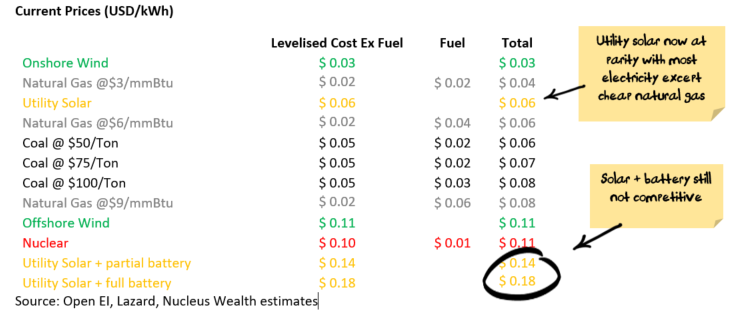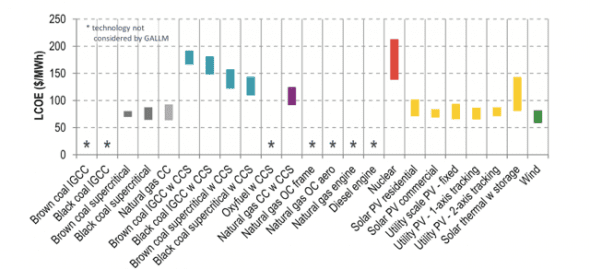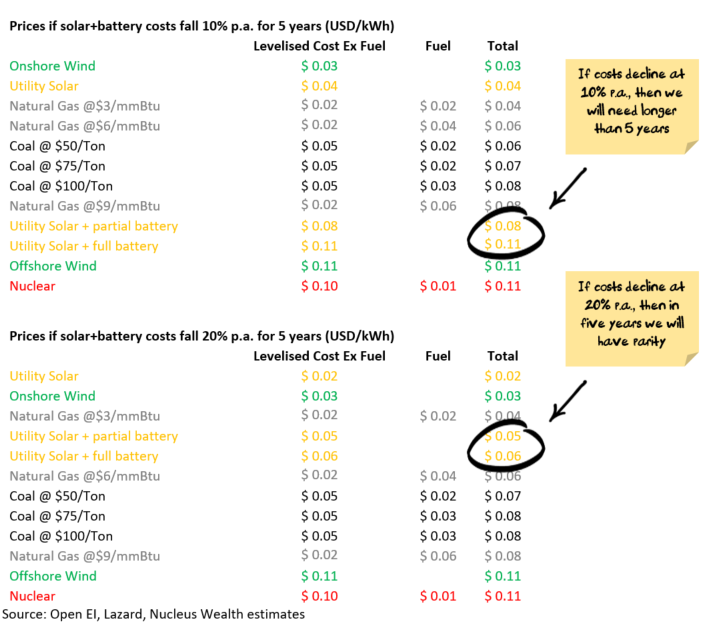Seriously Nuclear energy just does not financially stack up…

its because i think the ones that know it doesnt stack up just want to use it as a furphy.
but those that dont know the economics just use it to defer arguments of renewables of carbon pricing
But even under carbon pricing it still doesn’t stack up. The report I ripped the first picture from showed that even under carbon pricing nuclear still can’t compete with natural gas and renewable. Even looking at that picture, you can see gas with CCS is more competitive than nuclear, and CCS is way more expensive than any carbon price given it makes effective emissions zero but costs a shitload to retrofit.
Here is the energy cost report the first picture refers to:
I know all about pumped hydro, it’s been around for a long time. Personally I don’t care what form energy storage takes, be it chemical or gravitational potential, whatever is the cheapest form is good enough for me.
“Under ANU’s scenario, the levelised cost of energy (LCOE) of a 100 percent fully-stabilised grid powered with renewables would be around AU$75/MWh – cheaper than new coal and gas power.”
In the context of the 2030 picture that seems about right, although I am surprised that includes storage.

However if this is true, then I don’t see why we have anything to worry about. If renewables are that cost competitive then you’d think the market would be on the brink of doing this without government intervention. Although given how partisan energy policy has frozen investment and the market isn’t functioning there is still probably a need for government intervention.
Personally I would prefer that the dispatchable power assets/utilites which manage peak demand (e.g. OC peak gas turbines, hydro and battery storage) be publicly owned, since these forms of generation set the price and have a capacity to hold out for higher prices under uncompetitive conditions. Whereas intermittent generators have no choice in when they supply energy to the market, and as such are good for private operators to run.
Nuclear is becoming interesting. Modern reactors can use liquid fuel which means it’s impossible for them to melt down. They can use magnetic fields instead of thick containment units, so they are small and portable. They have modular designs so you can mass produce them instead of building each reactor as an individual project.
And yet, we still would probably fail with it because we just are so far behind with the technology now. We don’t have the tools to make the tools to make the tools…
Renewable energy is great, but the renewable energy target is not that great because it confuses means with ends. The purpose of climate policy should be to curb carbon emissions, not to pick winners in the energy market. Renewable energy is part of the solution to climate change, but not the whole solution. Other things like higher efficiency will help too, and the RET does nothing to support that. It’s easy to ignore RET critics, because they tend to be climate change deniers. But there is actually an element of truth to some of the economic arguments.
Ideally we would impose a carbon tax, scrap other taxes on energy (like GST), scrap all other mandates and interference in the energy market, and unban nuclear power. Ultimately we shouldn’t be pro- or anti-nuclear because that would once again be confusing means with ends. We should simply want the best brains working on climate change using the widest possible suite of options.
Is utility solar available 24 hours a day? We know that Nuclear is. Otherwise, we’d be comparing apples and oranges.
Reading the reports from the International Atomic Energy Commission, it’s probably worth keeping an eye on the development of Modular Small to Medium Reactors.
Basically, they are sealed modular units up to 300MW, constructed entirely in factory, and shipped to locations for operation. This would be one way to skip the long build process, skip the machines to build machines thing by just being a consumer at the end of that chain, and simplify operations. They’re not ready for prime time yet.
There’s still the issue of the 7000 tones of depleted heavy metal fuel accumulating each year, and the various other threats associated with just having fissile materials around.
Hands up if you want a nuclear fuel reprocessing plant in your city.
- Yes, I’m happy to have a nuclear fuel reprocessing facility in my city.
- No way.
0 voters
I am not sure reprocessing would need to be done in cities. Coal produces about 7,000 tonnes of radioactive waste every 5-10 minutes and we don’t see much of that in cities. Also reprocessed fuel is quite valuable (unlike coal slurry) and can be reused in certain types of plants. Closed loop production.
With all due respect John, if you examined closely those cost estimations for Solar they included battery storage, which effectively means we are comparing oranges with oranges. Unless there is something I am missing here it seems pretty clear cut to me from future cost estimations.
The irony is Mark that the RET was basically leant on because carbon pricing became such a touchy political issue, from what I can tell it was never the preferred mechanism but was more heavily relied upon due to political constraints.
The first obvious issue that jumps out at me is their (or rather, the ATO’s) estimate of the lifetime of a nuclear power plant. Even ancient models in the US were originally conservatively licensed at 40 years, never mind extensions, and yet they’re using a 30 year figure. I’d want to double check their workings.
As I said earlier, the economics are fiddly. You can ask three different organisations/countries and get three completely different answers. See here.
Yet you’re ignoring how every method of mass electricity generation needs regulation to various extents. And you’re also using effects of the ban on nuclear power to justify continuing the ban on nuclear power. Sort of.
“Becoming” interesting? Liquid fuel designs are old tech, prototyped at the 10MW scale in the 60s then mothballed since it didn’t work well for making bombs.
Agreed. Aside from regulating safety, externality, and natural monopoly issues the only other thing the government should be involved with is research.
Not that I want to defend coal, but there’s really no valid comparison there, except perhaps as a typical uneventful exposure from living near to a power plant (like in https://www.scientificamerican.com/article/coal-ash-is-more-radioactive-than-nuclear-waste/). In either case, it adds nothing significant to your background radiation exposure.
All of which entirely ignores the real issues around such processing facilities, which are about accidents or intentional harm, whereat I refer you back to: https://en.m.wikipedia.org/wiki/Nuclear_and_radiation_accidents_and_incidents
With respect 300MW is a tiddling small capacity site. I doubt that would be sufficient capacity for most medium-sized country towns. Compare with the Fukushima set (six reactors total 4.7GW - certainly that was one of the largest installations but - perspective please?)
I don’t know why you are confusing sites with reactors.
This is an argument against nuclear power. Too often (even in the case of our coal power stations) governments get lazy and extend the lifespan of plants which were never supposed to operate that long, with all the consequences that comes with that. You are essentially saying we should reduce the modelled effective cost of nuclear by ignoring design lifespan and converting those costs into negative externalities to make it viable. If we were to take that approach we could reduce the cost of every form of power generation since all generation assets have design a lifespan. That’s not a consistent argument.
Hey I wasn’t around when the decisions which lead to the current policy environment were made. I just evaluate the state of things as they are and look at optimal decisions on that basis. From the information I have available to me, the only way nuclear power would ever get off in Australia is with massive public subsidies, and (hopefully) public ownership. However it also seems absurd based on the current information available to me for the government to start building or even subsidising nuclear power. Unless energy generation is not your main purpose for building a reactor (i.e. nuclear weapons program), I can’t see how Nuclear power is an economically sensible decision in Australia.
It might be far more suitable for other countries which have poor renewable and non-renewable energy assets, or a well developed nuclear industry and need to import their energy in bulk. However in the Australian context it appears nonsensical.
Sigh. I wasn’t. I was rather being lazy and not breaking down a six-reactor set into single unit capacities. The fact remains that I very much doubt a 300MW reactor justifies the expense of its installation. For Pete’s sakes a nuclear submarine is powered by something not much smaller than that. Power a city? Nah!
For what it is worth this information site makes a lie of my earlier statement anyway, claiming instead:
“The 4,268MW (net) plant is owned and operated by TEPCO. The plant consists of four BWR units with gross capacity of 1,100MW and net capacity of 1,067MW each.”
